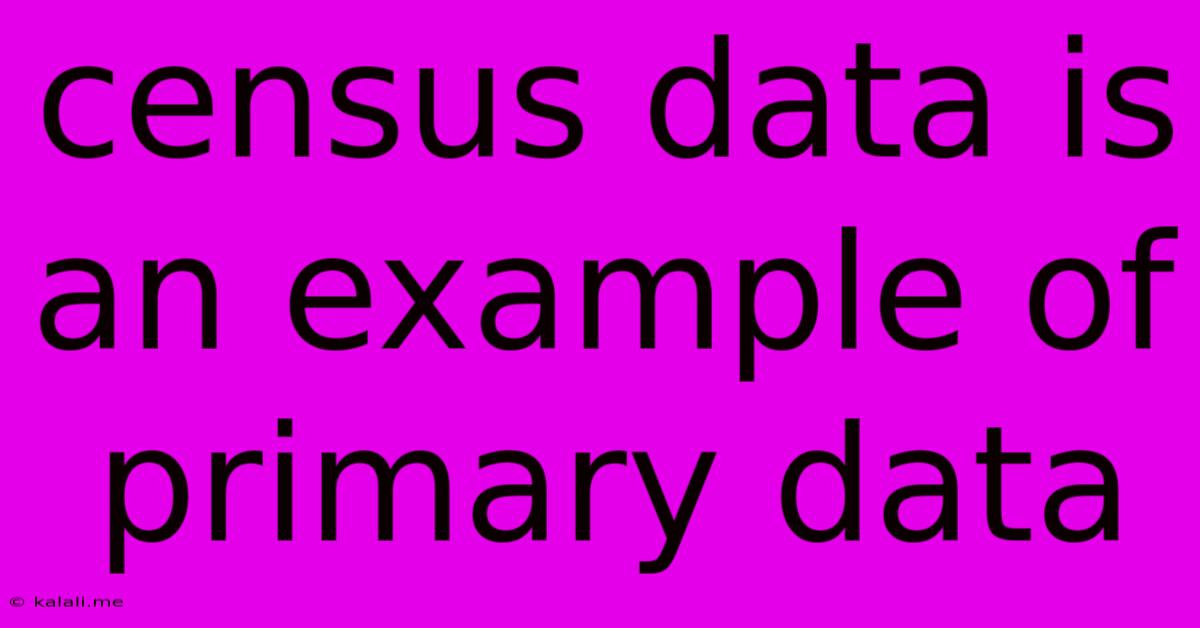Census Data Is An Example Of Primary Data
Kalali
Jun 14, 2025 · 3 min read

Table of Contents
Census Data: A Prime Example of Primary Data
Understanding the difference between primary and secondary data is crucial for any researcher, analyst, or anyone working with data. This article will explore why census data serves as a quintessential example of primary data, highlighting its characteristics and implications. We'll delve into what makes it primary, its value, and its limitations.
Census data, collected systematically through a census, represents information gathered directly from its original source. This direct collection is the defining characteristic of primary data. Unlike secondary data, which is derived from existing sources, census data is collected firsthand, making it a goldmine of raw, unfiltered information about a population.
What is Primary Data?
Primary data is data collected directly by the researcher or organization for a specific purpose. This involves designing the data collection method, gathering the information, and analyzing the results. It's "raw" data, untouched and uninterpreted by others before analysis begins. Think of surveys, experiments, interviews, and, importantly, censuses. The data is original and directly relevant to the research question.
Why Census Data is Primary: A Deep Dive
The census process itself perfectly embodies the principles of primary data collection. Governments employ various methods, including:
- Direct Interviews: Enumerators visit households and directly gather information from residents.
- Self-Reporting Forms: Individuals complete questionnaires independently, providing their own data.
- Administrative Records: Utilizing existing records, although these are often supplemented with direct contact to ensure accuracy and completeness.
In all cases, the data gathered is original and not derived from pre-existing sources. The information about demographics, housing, income, employment, and education is collected directly from the individuals or households involved. This direct collection eliminates the potential biases or interpretations that can be introduced when using secondary data.
The Value of Primary Census Data
The value of census data as a primary source is immense:
- Accuracy: When conducted properly, a census offers a high degree of accuracy concerning the population's characteristics.
- Representativeness: A well-executed census strives for complete coverage of the population, providing a representative picture.
- Timeliness: While not immediate, census data provides a snapshot of the population at a specific point in time.
- Basis for Policy: Governments rely heavily on census data to inform crucial policy decisions regarding resource allocation, infrastructure development, and social programs. It helps target areas needing specific support.
- Research Opportunities: Researchers across various disciplines utilize census data for a wide array of studies on social trends, economic development, and public health.
Limitations of Census Data
Despite its significant advantages, census data also has limitations:
- Cost: Conducting a census can be expensive and resource-intensive, requiring significant investment in personnel and infrastructure.
- Time: Data collection and processing require a considerable amount of time, meaning the data might not be immediately available.
- Undercounting: Certain populations may be underrepresented due to various factors, affecting the accuracy of the overall data.
- Data Privacy Concerns: Balancing data privacy with public access to information is a constant challenge. Careful handling and anonymization are crucial.
Conclusion: The Unmatched Power of Primary Census Data
Census data stands as a prime illustration of primary data, offering a detailed and comprehensive overview of a population. While it's not without its limitations, the value of this firsthand data for policymaking, research, and understanding societal trends is undeniable. Its accurate and representative nature, when properly collected, makes it an invaluable resource for a broad range of users. Understanding its characteristics helps appreciate the importance of primary data sources in gaining actionable insights.
Latest Posts
Latest Posts
-
Find Equation Of Plane Through Point And Parallel To Plane
Jun 14, 2025
-
1 Mole Of O2 In Grams
Jun 14, 2025
-
What Are All Factors Of 8
Jun 14, 2025
-
Choose The Correct Html Element For The Largest Heading
Jun 14, 2025
-
Light Wave Is Longitudinal Or Transverse
Jun 14, 2025
Related Post
Thank you for visiting our website which covers about Census Data Is An Example Of Primary Data . We hope the information provided has been useful to you. Feel free to contact us if you have any questions or need further assistance. See you next time and don't miss to bookmark.